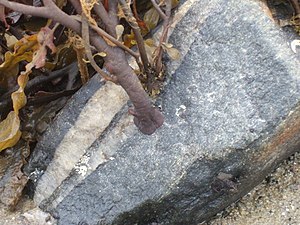AY Honors/Marine Algae/Answer Key
1. What is marine algae?
The most common name for marine algae is "seaweed". Seaweeds are popularly described as plants, but biologists do not consider them plants (in biology, all true plants belong to the kingdom Plantae). They should not be confused with aquatic plants such as seagrasses (which are vascular plants).
2. Where is it found?
Marine algae are mostly found in shallow ocean water near rocky shores.
3. What is the organ of attachment to the substratum called? How does it differ from a true root?
The organ that attaches a marine algae to a substrate is called a "holdfast" Unlike a root, a holdfast derives no nutrients from this intimate contact with the substrate..
Holdfasts vary in shape and form depending on both the species and the substrate type. The holdfasts of organisms that live in muddy substrates often have complex tangles of root-like growths, while those of organisms that live in sandy substrates are bulb-like and very flexible, such as the holdfast of sea pens, allowing the organism(s) to pull the entire body into the substrate when the holdfast is contracted. The holdfasts of organisms that live on smooth surfaces (such as the surface of a boulder) have the base of the holdfast literally glued to the surface.
4. How does size vary in marine algae?
Some marine algae are so small they can only be seen under a microscope. Others are very large, such as Macrocystis, a species of kelp belonging to the brown algae group, which may reach 60 meters![]() in length.
in length.
5. Name the four groups of marine algae, indicating opposite the name of each group whether it is unicellular, multicellular, or both.
| Group | Unicellular | Multicellular |
|---|---|---|
| Red Algae | ||
| Brown Algae | ||
| Green Algae | ||
| Diatoms |
6. Is most green algae found in fresh or salt water?
7. What are diatoms?
Diatoms are a major group of algae, and are one of the most common types of phytoplankton. Most diatoms are unicellular, although some form chains or simple colonies. A characteristic feature of diatom cells is that they are encased within a unique cell wall made of silica (hydrated silicon dioxide) called a frustule. These frustules show a wide diversity in form, some quite beautiful and ornate, but usually consist of two asymmetrical sides with a split between them, hence the group name.
Diatoms are a widespread group and can be found in the oceans, in freshwater, in soils and on damp surfaces. Most live in open water, although some live as surface films at the water-sediment interface, or even under damp atmospheric conditions. They are especially important in oceans, where they are estimated to contribute up to 45% of the base of the oceanic food chain.
8. Where does algae grow-the polar, temperate, or tropic zone?
Algae grow in all of these zones, from Picobiliphytes, which are an algae indigenous to polar regions, to Sargassum, which lives in the tropical waters of the Atlantic Ocean.
9. Where is brown algae most invariably found-in fresh or salt water?
Brown algae is found in salt water.
10. What is the greatest depth that algae grows in the ocean? Why can it not grow in deeper water?
The deepest living algae are those that are attached to the sea-bed under several meters of water. The limiting factor in such cases is the availability of sufficient sunlight to support photosynthesis. The deepest living sea-weeds are the various kelps.
11. Name the three parts of a large kelp. How do they compare to the leaf, stem, and root of a plant?
- Blade
- The blade is a large, flat structure, and is analogous to a plant's leaves.
- Stipe
- The stipe serves as a stem to which the blades are attached.
- Holdfast
- The holdfast is the part of the plant that anchors it to a substrate, such as a rock or the seafloor. It is analogous to a plant's root.
12. Describe the two ways that algae reproduce.
Sexual Reproduction
Most forms of algae reproduce sexually by forming spores. The spores, when cast off the adult organism, develop into male and female gametes which carry only half the genetic information of the parent organism. These gametes are motile, meaning they can move around by themselves, propelled by tiny flagella. When male and female gametes from the same or from different parent organisms combine, the genetic material fuses to create an organism with a full complement of genetic material. This is very similar to the way that ferns reproduce (see the Ferns honor for more details.
Asexual Reproduction
Asexual reproduction is advantageous in that it permits efficient population increases, but less variation is possible. Sexual reproduction allows more variation but is more costly because of the waste of gametes that fail to mate, among other things. Often there is no strict alternation between the sporophyte and gametophyte phases and also because there is often an asexual phase, which could include the fragmentation of the thallus.

